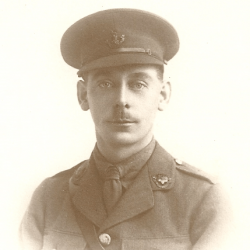George Frederick Barker was born in 1884, in Brentwood Essex to Frederick Inkerman Barker, (a blacksmith and farrier) and Kate Barker (née Monsear). George was the oldest of four children and the only son. His father died in 1903 and by 1911 he was living with his widowed mother and three sisters and employed as a school teacher for the Poplar Guardians (a poor house which built a training school for around 700 pupils in 1906/07 at Hulton in Essex). He was reportedly a fine athlete playing both football and cricket at a high amateur level in Brentwood.
He was commissioned as a temporary second lieutenant on December 5, 1914 and underwent his basic training with the 12th Battalion, The Essex Regiment. During this time, in the latter half of 1915, he married Lydia Laura Horwood. He deployed to Gallipoli, and on October 7, 1915 was attached to the 1/9th Battalion, Manchester Regiment along with 4 other junior officers from the Essex and South Lancashire Regiments.
There is no official mention of his movements or activities at Gallipoli save for a reference to reporting sick to hospital on December 8, 1915, most likely the 17th Stationary Hospital at Cape Helles. He remained in Hospital for six weeks until he was medically evacuated to Malta, disembarking on January 21, 1916 and diagnosed with Rheumatic Fever. There he was admitted to the Blue Sisters Hospital the following day. Two weeks later, on February 5th, he embarked on the Hospital Ship Aquitania bound for England via Naples.
On September 1, 1916 he was promoted to acting Lieutenant in the Training Reserve and remained so until February 16, 1917 when he relinquished his acting rank of Lieutenant and reverted to temporary 2nd Lieutenant. A week later he joined the 3rd (Reserve) Battalion, The Essex Regiment at Felixstowe, on February 22, 1917. The 3rd Essex was a depot and training unit and he remained there until he was passed fit for active service. Two months later he sailed to France and joined the 2nd Battalion, The Essex Regiment on April 22, 1917 while they were in billets at Beaufort-Blavincourt, a few kilometers West of Arras. The timing was not good as the Battalion was engaged in the Second Battle of Arras and both sides were suffering heavy casualties.
A week after his arrival, the Battalion moved into the front lines at 8pm on April 30, 1917. There they were subjected to enemy artillery and sniper fire and took several casualties. On May 3rd they were directly involved in an attack against the German positions and suffered 5 killed, 96 wounded and 106 missing other ranks with 2 officers killed, 8 wounded and 4 missing. The following day the battalion moved back to the support line. On May 10th they moved towards the front lines again when they supported an attack by the 11th Brigade. By this time the Battalion HQ was located in a cellar at Fampoux. On May 12th they were in the front lines again supporting an attack by the 10th and 11th Brigades. The battalion started to pull out during the evening and was fully relieved at midnight. The scale of the battalion’s casualties over the past month is made evident by an excerpt from the war diary entry for May 12:
“Only 4 Officers came out of the line with the Battalion out of 25 who had been with them this tour. 2 Officers wounded. 2/Lt. G. F. Barker killed.”
Temporary Second Lieutenant George Frederick Barker was killed in action on May 12, 1917 at Fampoux, France. He was 33 years old. His wife was notified by telegram 6 days later:
He is buried in the Saint Nicolas British Cemetery, Arras and commemorated at the Ilford War Memorial Hall.

